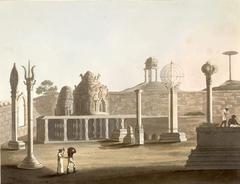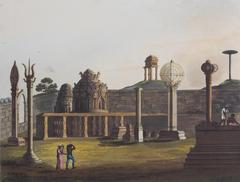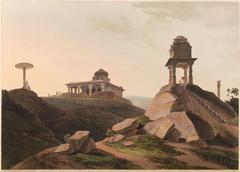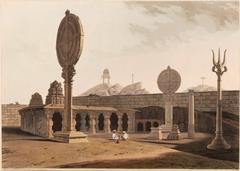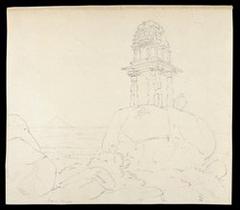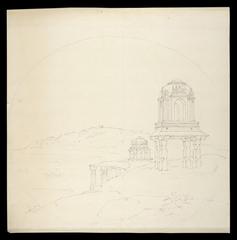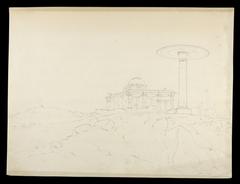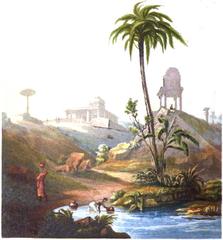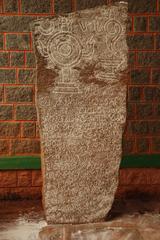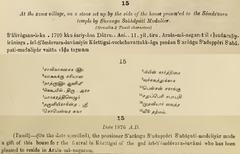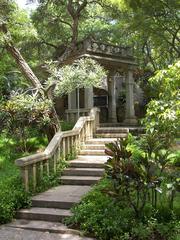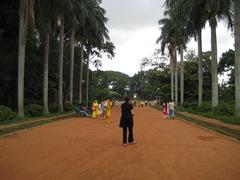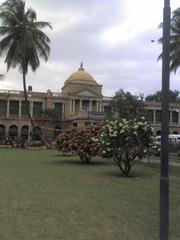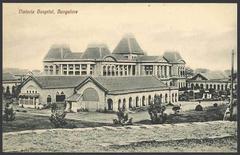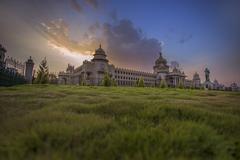
Gavi Gangadhareshwara Temple: Visiting Hours, Tickets, and Comprehensive Guide to Bengaluru’s Historic Sites
Date: 15/06/2025
Introduction
The Gavi Gangadhareshwara Temple, nestled in Bengaluru’s Gavipuram area, stands as a profound testament to India’s spiritual, historical, and architectural heritage. Also known as the Gavipuram Cave Temple, it is one of the city’s oldest religious sites—carved directly into a granite hill and famed for its unique rock-cut architecture and remarkable astronomical alignment. Dedicated to Lord Shiva as Gangadhareshwara, the temple is steeped in legend and history, drawing devotees, history enthusiasts, and travelers to witness its tranquil sanctum, major festivals, and the mesmerizing Makara Sankranti sunlight phenomenon (The Divine India; Wikipedia).
This guide provides a detailed overview of the temple’s origins, architecture, religious and cultural significance, visiting hours, ticketing, accessibility, major festivals, daily rituals, nearby attractions, and practical travel tips for a memorable experience (bangaloretourism.in; traveltriangle.com).
Table of Contents
- Origins and Historical Evolution
- Architectural and Astronomical Marvels
- Religious and Cultural Significance
- Legends and Mysteries
- Role in Bengaluru’s Cultural Identity
- Visiting Information
- Notable Features and Artistry
- Major Festivals
- Daily Rituals and Pooja Schedule
- Visitor Experience
- Nearby Attractions
- Practical Tips
- Frequently Asked Questions (FAQ)
- Visuals and Media
- Internal and External Links
- Summary and Recommendations
- References
Origins and Historical Evolution
Gavi Gangadhareshwara Temple’s origins are a blend of legend and historical record. While local tradition attributes the earliest construction to the Vedic era—sages like Gautama Maharishi are said to have performed penance here—the temple’s current structure was extensively renovated in the 16th century by Kempe Gowda I, founder of Bengaluru (The Divine India; Wikipedia). Archaeological and pictorial evidence, including 18th-century paintings by British artists, confirm its enduring significance (Wild Valley).
Protected under the Karnataka Ancient and Historical Monuments and Archaeological Sites and Remains Act, the temple is recognized as a heritage monument (Myoksha).
Architectural and Astronomical Marvels
Carved into a granite hill, the temple’s subterranean layout and monolithic pillars distinguish it from typical South Indian temples. “Gavi” means cave in Kannada, reflecting its underground sanctum accessed by descending steps (Livemint). The temple’s astronomical alignment is its most celebrated feature—during Makara Sankranti in mid-January, the setting sun’s rays pass through an aperture between the horns of the Nandi statue and illuminate the Shiva Linga within the sanctum (Wild Valley; The Divine India).
The forecourt features four monolithic pillars representing the Damaru (drum), Trishul (trident), and two discs symbolizing the sun and moon—serving both as architectural marvels and celestial markers (Wikipedia; Myoksha).
Religious and Cultural Significance
The temple is a prominent Shaivite pilgrimage center, revered for its spiritual atmosphere and healing powers. The rare Agnimurthi idol (depicting the fire god Agni) is believed to cure eye ailments (The Divine India; Viharadarshani). Major festivals such as Makara Sankranti and Maha Shivaratri draw thousands of devotees to witness rituals and the sunlight phenomenon (Widexplore).
Legends and Mysteries
Myths of secret tunnels beneath the temple—rumored to connect to Kashi (Varanasi) or Shivagange—enhance its mystique, though these remain unexplored and sealed (The Divine India; Viharadarshani). Kempe Gowda’s association with the temple’s restoration after his imprisonment further weaves it into Bengaluru’s history (Wild Valley).
Role in Bengaluru’s Cultural Identity
Located in the heart of Gavipuram, the temple’s presence has shaped the neighborhood’s identity. As a protected monument, it is central to heritage walks, educational tours, and local cultural festivals (Widexplore; Livemint).
Visiting Information
Visiting Hours
- Regular Hours: 6:00 AM – 12:30 PM and 5:00 PM – 8:00 PM daily
- Festival Hours: Extended during Makara Sankranti and Maha Shivaratri (traveltriangle.com)
Entry Fees
- Entry: Free for all visitors (gokshetra.com)
Accessibility
- Steps descend into the cave; wheelchair access is limited. The outer courtyard is accessible.
How to Reach
- By Metro: National College Metro Station (Green Line), ~2 km away (Yometro)
- By Bus: BMTC buses to Kempegowda Nagar
- By Taxi/Auto: Readily available across Bengaluru
Best Time to Visit
- Makara Sankranti (mid-January): For the sunlight phenomenon
- September–December: Pleasant weather, fewer crowds
Dress Code and Etiquette
- Modest, traditional attire recommended. Footwear must be removed before entry. Photography is allowed in the courtyard but restricted inside the sanctum (xploringdestinations.com).
Facilities
- Restrooms, drinking water, and footwear stands available. Vendors sell puja items outside the temple.
Notable Features and Artistry
The temple houses elaborate carvings, monolithic sculptures, and statues such as the Nandi and Shakti Ganapathi. The forecourt’s stone discs and pillars showcase advanced astronomical and architectural knowledge (Wikipedia; Wild Valley).
Major Festivals
Makara Sankranti
The temple’s most significant festival, marked by the rare sunlight event illuminating the Shiva Linga, accompanied by special rituals and communal prayers (bangaloretourism.in; traveltriangle.com).
Maha Shivaratri
A night-long celebration with continuous rituals and abhishekas, drawing large crowds (traveltriangle.com).
Other Hindu Festivals
The temple also celebrates Deepavali, Navaratri, Ugadi, and other major festivals (xploringdestinations.com).
Daily Rituals and Pooja Schedule
- Morning Pooja: 6:00 AM – 12:30 PM
- Evening Pooja: 5:00 PM – 8:00 PM
- Key Rituals: Abhisheka (bathing of Shiva Linga), Archana (personal prayers), Aarti (waving of lamps), and distribution of prasadam (gokshetra.com).
Visitor Experience
The temple’s serene, cave-like ambiance offers a tranquil retreat from city life. Its cool interiors, intricate carvings, and interplay of light and shadow—especially during Makara Sankranti—create a mystical atmosphere (bangaloretourism.in).
Crowds are well managed during festivals, with volunteers assisting visitors. Local guides can be engaged for deeper insights into the temple’s history and architecture.
Nearby Attractions
- Bull Temple (Nandi Temple): ~1.5 km
- Dodda Ganapathi Temple: Adjacent to Bull Temple
- Lalbagh Botanical Garden: ~3 km
- Tipu Sultan’s Summer Palace: ~4 km
- Gandhi Bazaar: ~2 km
Nearby, Basavanagudi offers traditional markets and iconic South Indian eateries, while accommodation options range from budget to luxury hotels (hoteldekho.com; xploringdestinations.com).
Practical Tips
- Arrive early during festivals to avoid crowds and witness the sunlight phenomenon.
- Carry bottled water and wear comfortable, respectful clothing.
- Use public transportation or arrive early if driving, as parking is limited.
- Download the Audiala app for real-time updates, travel tips, and virtual tours.
Frequently Asked Questions (FAQ)
Q: What are the Gavi Gangadhareshwara Temple visiting hours?
A: Daily from 6:00 AM to 12:30 PM and 5:00 PM to 8:00 PM; extended on festival days.
Q: Is there an entry fee?
A: No, entry is free.
Q: How accessible is the temple?
A: The cave structure involves steps; the outer courtyard is accessible for those with limited mobility.
Q: When is the best time to see the sunlight phenomenon?
A: During Makara Sankranti (January 14th or 15th) around 5:20 PM.
Q: Are guided tours available?
A: No official tours, but local guides and priests can be consulted at the entrance.
Q: Is photography allowed?
A: Permitted in outer areas; restricted inside the sanctum.
Visuals and Media
For high-quality images, an interactive map, and virtual tours, visit our website.
Internal and External Links
- External: Darshan Time, Yometro
Summary and Recommendations
The Gavi Gangadhareshwara Temple is an extraordinary blend of faith, history, and scientific mastery. Its ancient rock-cut architecture and precise solar alignments during Makara Sankranti fascinate both scholars and devotees, while daily rituals and grand festivals foster a vibrant spiritual community. Located in the culturally rich Gavipuram neighborhood and close to other major heritage sites, the temple is a must-visit for anyone exploring Bengaluru’s historical and spiritual landscape.
Visitors should plan their trips around the temple’s visiting hours, observe the dress code, and consider accessibility needs. For the most rewarding experience, schedule your visit during Makara Sankranti, consult local guides, and explore nearby attractions. Download the Audiala app for curated travel recommendations, and follow us on social media for the latest updates.
References
- Gavi Gangadhareshwara Temple Bengaluru: Visiting Hours, Tickets & Historical Guide, The Divine India
- Gavi Gangadhareshwara Temple - Wikipedia
- Amazing Facts About Sri Gavi Gangadhareshwara Temple, Wild Valley
- Gavi Gangadhareshwara Temple History, Timings, Festivals, Viharadarshani
- Gavi Gangadhareshwara Temple - Myoksha
- The Mysteries of Bengaluru’s Famed Gavi Gangadhareshwara Temple, Livemint
- Gavi Gangadhareshwara Temple, Bangalore, Bangalore Tourism
- Gavi Gangadhareshwara Temple - Travel Triangle
- Gavi Gangadhareshwara Temple Darshan Guide, Gokshetra
- Gavi Gangadhareshwara Temple: A Glimpse into Bengaluru’s Historic Spiritual Landmark, Widexplore
- Gavi Gangadhareshwara Temple Visiting Hours, Tickets, and Guide to Bengaluru’s Historic Sites, Yometro
